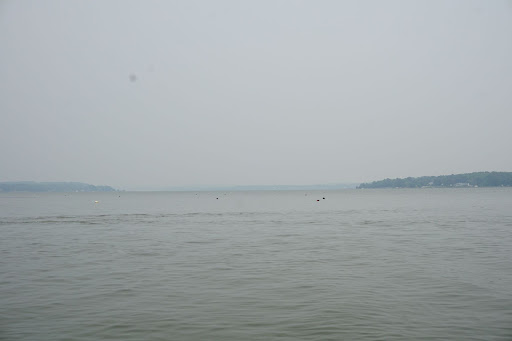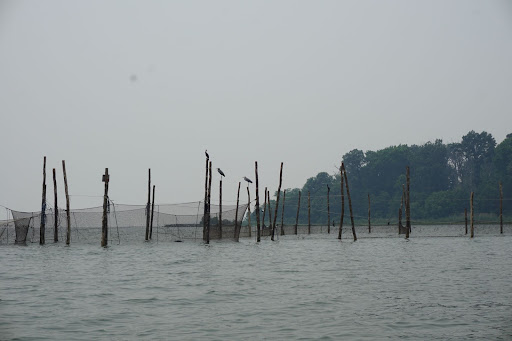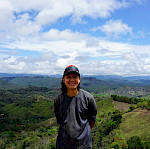On the River with Darion and Tre
Darion Fredericks, Tre’Nard Morgan ·Classified as “the nation's river”, the Potomac River is a source of history and culture, and is an ecological keystone in the Chesapeake Bay. The Potomac River crosses Maryland, Virginia, Pennsylvania, Washington D.C., and West Virginia. This historic river is home to over 100 species of freshwater fish, approximately 100 species of birds, and 60 mammals including smaller amphibians and reptiles. On June 7th, we embarked on our journey to visit this revered river in person and learn more about the significant impact it has. We used kayaks to traverse the water and identified multiple features that showed the restoration acts initiated yielded some benefits to the improvement of the water quality, but there is still much research and action needed to restore it to its former glory.

Unfortunately, our river adventure was hindered by smoke that had made its way south from the Canadian wildfires raging in the North. It affected visibility both on land and on the water, with an eerie haze lingering throughout the day. We shared photos amongst ourselves from the internet, friends, family members, with all of them showing the effects of smoke in different locations. Some resembled hellish cityscapes, while others depicted the unnatural looking skies. As we lathered ourselves in sunscreen and went over water safety, there were also concerns of air quality, some of our group chose to wear masks to protect from the smoke. Despite the inconvenience, our river trip continued unimpeded.
Along the way, it picks up water from key tributaries including the Anacostia, Shenandoah, and Monocacy rivers, and connects people to nature. Its watershed of 14,670 square miles is nearly 60 percent forest, qualifying it as one of the most forested in the country. It provides critical habitat for wildlife and multiple species of fish while offering the nation’s capital a place to play. -American Rivers

Our journey in the Potomac was very engaging and informative as our wonderful guide and canoe provider, Lou, told us about the Chesapeake Bay history and how the area has changed since the founding fathers era. Industrialization and population increase has played a big part in impacting the water quality as some areas closer to shore were more murky compared to further out areas. As we traversed the waters, our guide Lou brought us to a stop along a giant fish trap partially submerged. He elaborated how effective the trap was as well as its historical use. Blue herons sat perched atop the trap poles, perhaps waiting for a midday snack from the fish trapped beneath.

Bill Dennison provided a wide array of environmental insight, discussing how the health of the Potomac has changed over time and how the area is continuing to heal today. He also shared the rich colonial history of the Potomac, from it being used as a way of sneaking into Washington, D.C. and the various battles that occurred over ownership of the river throughout history. It helped create an interesting mental picture to imagine what these battles might have looked like and wonder what the landscape might have looked like before all the modern changes.
The biodiversity of the Potamac was unreal, the group was able to see multiple species of plants and animals throughout the journey. There were loblolly pine, some oak trees, and a lot of seagrass in the water we were floating above. We also noticed there was a high presence of invasive grass that was along the river bank. We were able to actually see a blue crab up close and personal; unfortunately, it was already dead while attached to some water vegetation. One of the most interesting animals was the freshwater jellyfish we spotted along the seagrass.

Overall, the trip provided us an opportunity to bond with our team members, and also immerse ourselves in the awe-inspiring environment of the Potomac. It is interesting how your troubles sort of melt away for a few hours as you focus on the flow of rowing and paying close attention to the world around you. Our trip started with a sighting of a bald eagle, which gave us a sense of comfort that it would be a good day, and it was. We are all eager to learn more about this river and the secrets it keeps, as well as working to keep it safe and healthy in perpetuity.
About the authors
Darion Fredericks

Darion is a Global Sustainability Scholar working on the Coastal Ocean Assessment for Sustainability and Transformation (COAST Card) project through the UMCES Integration and Application Network (IAN). His interests are community-based research and food systems analysis, with a focus on building reciprocal relationships between citizens, the scientific community, and the environment. Darion is a rising senior at Fort Lewis College in Durango, Colorado, pursuing a degree in Environmental Conservation & Management with a certificate in Regenerative Food Systems.
Tre’Nard Morgan

Tre’Nard is a Global Sustainability Fellow on the Coastal Ocean Assessment for Sustainability and Transformation (COAST Card) project through the UMCES Integration and Application Network (IAN). He is a rising second year pursuing his Masters degree in Environmental Justice and Urban Planning at the University of Michigan. His passions include working in urban development to create more equitable spaces for BIPOC community members and elevating the living conditions of underdeveloped communities.